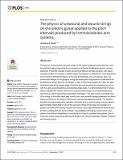Files in this item
The physics of unwound and wound strings on the electric guitar applied to the pitch intervals produced by tremolo/vibrato arm systems
Item metadata
| dc.contributor.author | Kemp, Jonathan Andrew | |
| dc.date.accessioned | 2017-09-22T09:30:07Z | |
| dc.date.available | 2017-09-22T09:30:07Z | |
| dc.date.issued | 2017-09-21 | |
| dc.identifier | 251006609 | |
| dc.identifier | fdc5f5b7-a752-4d40-b3db-7345c7627eb7 | |
| dc.identifier | 85029690416 | |
| dc.identifier | 000411339900045 | |
| dc.identifier.citation | Kemp , J A 2017 , ' The physics of unwound and wound strings on the electric guitar applied to the pitch intervals produced by tremolo/vibrato arm systems ' , PLoS One , vol. 12 , no. 9 , e0184803 . https://doi.org/10.1371/journal.pone.0184803 | en |
| dc.identifier.issn | 1932-6203 | |
| dc.identifier.other | ORCID: /0000-0002-3861-4863/work/37034238 | |
| dc.identifier.uri | https://hdl.handle.net/10023/11716 | |
| dc.description.abstract | The physics of wound and unwound strings on the electric guitar are presented here, and the pitch intervals produced by the movements of a Fender Stratocaster tremolo unit are explained. Predicted changes in pitch sensitivity of different strings are given, and experimentally verified, for changes in saddle height, the distance of string free to move behind the nut and ratio of diameters/masses of the core and windings of wound strings. Also, it is shown that changes to the gauge of strings (assuming the string tension is sufficient for linear behaviour and in absence of changes to other construction details) don’t alter the pitch intervals produced by a given angle of tremolo arm use assuming the instrument is set up with the same sounding pitches and starting bridge angle. It is demonstrated that it not possible to equalise the relative sensitivity of unwound steel stings on a Fender Stratocaster type tremolo unit through string construction techniques. The ratio of core to winding mass in the string, on the other hand, was found to be a very powerful design parameter for choosing the sensitivity of the string to tremolo arm use and standard pitch bends. For instance, the pitch intervals produced by operation of tremolo arm for wound strings may be made to approximately match that for one of the unwound strings if they share very similar core gauges (assuming the winding masses are chosen to give approximately the same tension at their sounding pitches). Such a design, only available currently by custom order, also delivers the optimum equalisation in sensitivity of strings for standard string bends (due to these also being produced by altering the length of the string to generate changes in tension and therefore pitch). | |
| dc.format.extent | 25 | |
| dc.format.extent | 2811087 | |
| dc.language.iso | eng | |
| dc.relation.ispartof | PLoS One | en |
| dc.subject | Guitar | en |
| dc.subject | String | en |
| dc.subject | Electric | en |
| dc.subject | Pitch | en |
| dc.subject | Interval | en |
| dc.subject | Tremolo | en |
| dc.subject | Arm | en |
| dc.subject | Bend | en |
| dc.subject | Vibrato | en |
| dc.subject | Bar | en |
| dc.subject | Music | en |
| dc.subject | MT Musical instruction and study | en |
| dc.subject | QC Physics | en |
| dc.subject | Acoustics and Ultrasonics | en |
| dc.subject | Music | en |
| dc.subject | Mechanics of Materials | en |
| dc.subject | Mechanical Engineering | en |
| dc.subject | NDAS | en |
| dc.subject.lcc | MT | en |
| dc.subject.lcc | QC | en |
| dc.title | The physics of unwound and wound strings on the electric guitar applied to the pitch intervals produced by tremolo/vibrato arm systems | en |
| dc.type | Journal article | en |
| dc.contributor.institution | University of St Andrews. Music Centre | en |
| dc.identifier.doi | https://doi.org/10.1371/journal.pone.0184803 | |
| dc.description.status | Peer reviewed | en |
This item appears in the following Collection(s)
Items in the St Andrews Research Repository are protected by copyright, with all rights reserved, unless otherwise indicated.

